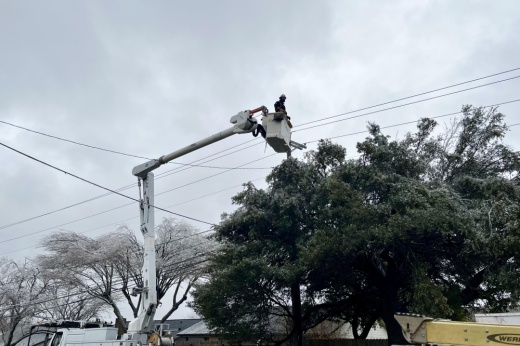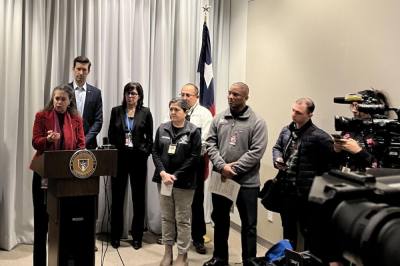Updated Feb. 2 at 7:20 p.m.
Austin Energy officials announced Feb. 2 the 25% of customers without power can no longer expect it to be restored by 6 p.m. Feb. 3, and they are unable to provide an estimate for when it will be turned back on.
Elton Richards, AE vice president of field operations, said the outages were caused by historic ice and precipitation, and not poor vegetation management, despite the fact that fallen trees were responsible for the majority of outages. Austin Energy General Manager Jackie Sargent stated on Feb. 2 and Feb. 3 that some of the issue could have been prevented by better management, but that some of the issues—such as tall trees completely falling over and taking out lines—could not have been prevented through management. She said on Feb. 2 that Austin Energy would work with the city to update the vegitation management regulations and that customers can asssit by allowing Austin Energy to maintain trees.
"The majority of outages from this winter storm are complex, [requiring] heavy construction equipment in areas that are sometimes impassable due to downed trees and branches,” Austin Energy General Manager Jackie Sargent said.
Austin Energy requires all fast-growing trees, such as pecan, to have a 15-foot clearance from power lines, and slow growing trees, such as juniper, must have a 10-foot clearance.
Richards said Austin would have had to set over a 30-foot clearance requirement for trees to not have caused downed power lines due to the storm, as some of the trees causing outages are over 50 feet tall.
Austin Energy does not have an average repair time per outage because each outage is complex, and crews are continuing to run into new obstacles, Richards said.
“We’ve done every conceivable repair we could have done in the past two days,” Richards said.
During a 12-hour period Feb. 1, Austin Energy restored power for 24,000 customers while 21,000 customers lost power, causing the outage map to look static, Richards said.
Further, ice and tree limbs have continued to knock out power lines that were just restored, Richards said.
“Austin Energy is one of the most reliable [companies] I’ve worked for,” Richards said. “This was truly an act of God.”
Sargent said residents without power can expect badged AE employees to knock on their doors to gain access to equipment.
Residents without power can warm up at libraries and park facilities during the day and the One Texas Center overnight. Anyone needing a ride or shelter information can call 311.
City Council members will be holding a Feb. 7 work session to field questions about Austin Energy.
Austin Water Director Shay Roalson said they do not anticipate putting out a systemwide boil-water notice, as treatment plants have been operating normally, and water storage levels are healthy; however, there are small pockets of residents—just shy of 40—who do need to boil their water, and they have been contacted directly.
Updated Feb. 2 at 4 p.m.
Austin Energy said it can no longer provide an estimate for when systemwide power restorations can be complete as of the afternoon of Feb. 2.
At a 9 a.m. press conference with Austin and Travis County leadership, Austin Energy General Manager Jackie Sargent originally said all repairs would be completed by the evening of Feb. 3.
More updates are expected at a joint press conference that will be held at 5 p.m. This article will be updated with the latest information.
Posted Feb. 2 at 11 a.m.
Austin Energy expects to complete restoration work on downed power lines by the afternoon of Feb. 3, Austin Energy General Manager Jackie Sargent said at a Feb. 2 press conference.
More than 100,000 residents have experienced outages due to power lines downed by ice and falling trees during winter conditions that started Jan. 31, many overnight.
“We are experiencing one of the most widespread ice storms to hit Austin, and certainly one of the worst,” Sargent said.
As of the 9 a.m. conference held by city and county leaders, 82 crews are working to restore power, including 32 from neighboring utility organizations, Sargent said. More crews from Houston are expected later Feb. 2.
“While we sit inside, those workers are out in the cold working to keep the lights on and working to restore power to everybody in Travis County, and they deserve our respect and our patience,” Travis County Judge Andy Brown said.
Since at least mid-day Feb. 1, the Austin Energy outage map has shown roughly 30% of customers without power.
“It may look like no progress has been made, but we have restored power to 113,000 customers,” Sargent said. “So far, it feels like two steps forward and three steps back.”
Information on emergency shelters can be found here. Anyone who is unable to drive to a shelter can call 311 for assistance.
Sargent said there were some issues with the map due to the number of people trying to use the online tool, but Austin Energy was able to get it straightened out with their website vendor. She also said some residents may not be able to report outages if Austin Energy is aware of the issue, due to the volume of reports.
She said customers should look at the map if their electricity is out. If they see a large outage nearby, that is likely the cause of their issues even if the marker on the map is not directly at their location.
Sargent said the event differs from the deadly winter storm in 2021 because crews were able to restore all power lines prior to the statewide call for rolling blackouts. She said the ice has been significantly worse during this storm.
“The amount of weight that has accumulated on the vegetation is probably [a] historic extreme,” Sargent said.
Sargent said it is unknown what the cost of the restoration work will be, and that at this time there are no plans to raise energy rates for customers. She said customers should be aware they may need to contact an electrician to fix their personal equipment in certain instances to restore power once Austin Energy has completed its work.
Sargent, when asked about why Austin’s utilities lines are not buried in much of the city, pointed to cost. She said retroactively burying power lines is expensive, and buried lines come with other vulnerabilities, such as floods.
In response to questions about tree maintenance, Sargent said Austin Energy has increased its focus on vegetation maintenance over the last few years. She said customers could assist Austin Energy by allowing crews to trim trees as needed, and Austin Energy would be working with policymakers to revise rules meant to protect the urban canopy that have limited preventative maintenance.
In response to a question about why a press conference was not held earlier, Austin Mayor Kirk Watson said he deferred to staff in emergency management organizations.
“But I am frustrated, and I know others are frustrated,” Watson said. “[Press conferences] need to happen on a more frequent basis. But we ought to focus now on the life and safety issues. ... And then we'll come up with a new way to do this so that we're able to answer those questions in a more rapid fashion.”
The Office of Homeland Security and Emergency Management provided the following tips for residents who want to stay in their homes and do not have power:
- Wear several layers of light weight, warm clothing rather than one layer of heavy clothing.
- Wear hats, mittens and blankets indoors.
- Close curtains and cover windows and doors with blankets.
- Try to stay together in one room, with the door closed, to keep in body heat.







